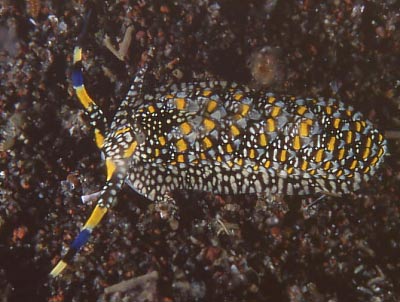
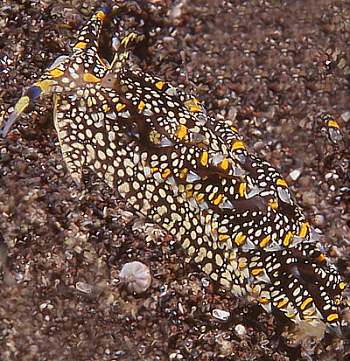
Cerberilla albopunctata
Baba, 1976
Order: NUDIBRANCHIA
Suborder: AEOLIDINA
Family: Aeolidiidae
DISTRIBUTION
Known from Pacific coast of central and southern Japan.
PHOTO
Osezaki, Izu-Hanto Peninsula, Japan. March 2001. 12m, in sand, crawling at night. Approx 4 cm long. Photo: Daisuke Suzuki
Body and foot dark brown with large opaque white spots of different sizes scattered over the body, foot, cerata, oral tentacles and rhinophores. The inner (or lower) surface of the cerata is a uniform dark brown while on the upper surface the dark brown cerata are covered with white spots except for the upper third or quarter which has a broad yellow band, then an opaque white cap and a dark brown extreme tip. The rhinophores are smooth and small. They are translucent brown with white spots except for the tip which has a darkbrown subapical band and a yellow tip. The long oral tentacles are spectacularly coloured with bright yellow, blue, dark brown and white bands. It grows to at least 40mm long.
Reference:
• Baba, K. (1976). The genus Cerberilla of Japan (Nudibranchia: Eolidoidea: Aeolidiidae), with the description of a new species. The Veliger, 18(3):272-280.
Rudman, W.B., 2002 (February 18) Cerberilla albopunctata Baba, 1976. [In] Sea Slug Forum. Australian Museum, Sydney. Available from http://www.seaslugforum.net/find/cerbalbo
Related messages
Cerberilla albopunctata from East Timor
February 15, 2006
From: Brian Francisco
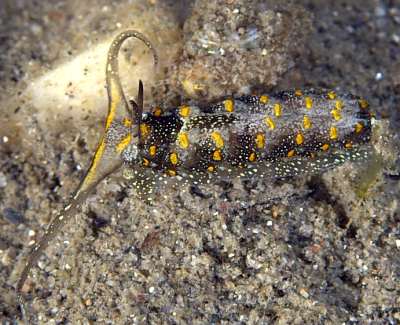

Hi Bill,
We think this animal is in the family Aeolidiidae, perhaps a juvenille species of Cerberilla. The individual was quite small.
Locality: Sandy Bottom, 14 meters, East Timor, Banda Sea, 10 February 2006, sandy slope. Length: approx 1 cm. Photographer: Brian Francisco
Thanks for your help.
Brian
francisco.brian@gmail.com
Francisco, B., 2006 (Feb 15) Cerberilla albopunctata from East Timor. [Message in] Sea Slug Forum. Australian Museum, Sydney. Available from http://www.seaslugforum.net/find/15825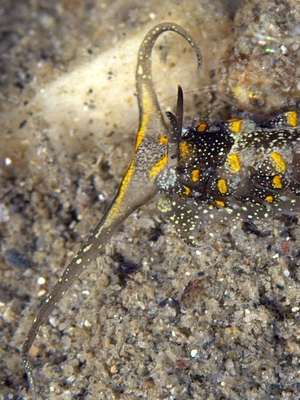
Dear Brian,
This is indeed a Cerberilla, and I think it is Cerberilla albopunctata, a species previously only recorded from Japan. Your animal desn't have the distinct colour markings on the oral tentacles you can see on Japanese specimens, but I suspect that is because your animal is a juvenile.
If it is the same, does that mean it has just arrived in Esat Timor? I doubt it, the most likely explanation is that not many people have been looking at these animals in your part of the world previously. Since they spend much of their time buried in the sand, they are not the first thing seen by reef divers
Best wishes,
Bill Rudman
Cerberilla albopunctata from Japan
February 20, 2002
From: Daisuke Suzuki

Dear Dr Bill Rudman
Please excuse the sudden mail. It is a pleasure to make your acquaintance. I am a diving guide at Osezaki in the Izu-Hanto Peninsula, Japan.
I take photographs underwater and the other day, as I was sorting out my photographs for the first time in a while, I ran across something that I just can't seem to figure out. I even looked through some overseas Websites, but there was nothing that looked the same. So, I've taken the liberty to send you the images in hopes that you might somehow be able to check it out for me.
Photo site: Osezaki, March 2001. Water depth 12m. About 4 cm in size. In the sandy area, during the night.
Sincerely,
Daisuke Suzuki
daisuke@po4.across.or.jp
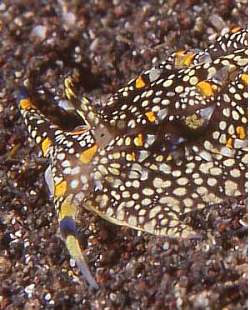

Dear Daisuke,
This is an aeolid nudibranch belonging to the genus Cerberilla. They are probably much more common than we think because they are usually live buried in sand, often coming to the surface at night. Because they are seldom seen alive we know little about their biology and natural history but we think they feed on sand-dwelling sea anemones.
Your animal is Cerberilla albopunctata. Have a look at the Fact Sheet I have prepared for further information on the species.
Best wishes,
Bill Rudman
